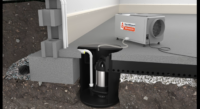A wet basement is a scenario that no homeowner wants to experience, but it is a relatively common occurrence. As it rains, water seeps down and raises the water table. As that water reaches the foundation, it creates what’s known as hydrostatic pressure, placing great amounts of stress on the concrete. That pressure can cause Read more
Todd Prosan

A wet basement is a scenario that no homeowner wants to experience, but it is a relatively common occurrence. As it rains, water seeps down and raises the water table. As that water reaches the foundation, it creates what’s known as hydrostatic pressure, placing great amounts of stress on the concrete. That pressure can cause various problems ranging from water seeping through the basement cove joint to cracks appearing in your concrete. Only through the addressing of hydrostatic pressure can these problems be stopped.
But not every basement waterproofing system is made the same. Even with an interior basement waterproofing system in place, if the components are not properly installed or well-designed, the system can fail. This means that all that money you spent to fix your basement must be spent again.
This is called tear or rip out, where the original system must be torn out and replaced with a new one.
To keep your basement protected from the effects of intrusive groundwater and moisture, it is crucial to have it waterproofed with quality products and methods that will perform even under serious conditions such as heavy rainstorms.

Components in a Basement Waterproofing System
Even if there aren’t cracks in your floor slab or basement wall, water can still seep through the cold joints because of this water pressure (hydrostatic pressure). By targeting this hydrostatic pressure, you can keep the water out of your home. This requires what’s known as an interior basement waterproofing system.
The components for an interior basement waterproofing system typically include:
- Drainage channels, also known as drain tile and sometimes French drains
- A sump pit and a sump pump
Depending on your situation, there may be other components required such as vapor barriers and dehumidifiers. But the main drivers for your basement waterproofing system’s performance are the drainage channels and the sump pump—without these two, there’s no ability to capture and remove incoming groundwater when it rains.
Let’s take a closer look into how to make sure that your drainage channels and sump pump are prepared for any rainy day…
Drainage Channels
Drainage channels can come in different forms and sizes. This is important to know because these channels can affect the performance and longevity of your basement waterproofing system’s drainage ability.
The Most Common Drainage Channels
Commonly used drainage channels tend to come in the form of perforated corrugated channels. The reason corrugated pipe is the most common product is that it’s the cheapest for the contractor to buy.
Corrugated pipe comes in a giant roll, like a garden hose, but it’s wider, from three to four inches wide. But it’s wiggly and difficult to install straight.
There are a number of disadvantages to using corrugated channels including:
The coiled shape of the corrugations creates grooves that trap debris and water, leading to sitting water, debris build-up, and eventually clogged drainage channels.
Corrugated drains are hard to install flat—they tend to bend, rise and dip, leading to an uneven path for water. The potential to trap water rather than flow it towards the sump pit is commonplace.
These drainage channels tend to have small perforations, which means less water is able to enter at any one time, and it can be prone to get clogged by debris.
Even non-corrugated drainage channels may have trouble transporting water fast enough. A round drainage channel can lead to debris settlement, slowing down water flow and eventually clogging.

Specially Designed Drainage Channels for Interior Waterproofing
There are two significant design differences in interior drainage channels.
- On-the-footer design
- Beside-the-footer design
These differences make all the difference to draining water from your basement.
- On-the-footer systems are designed to be installed faster and easier but drain less water.
- Beside-the-footer systems require more labor but provide for a larger capacity and faster discharge of water.
The price difference? Negligible.
The Differences in Basement Drainage Channels: On-the-footer vs. Beside-the-footer
- On-the-footer systems are installed on the concrete footer of the home. The footer is built to be perfectly level. This is so that the rest of the structure that sits on the footer has a level starting point. Putting a drainage channel on top of the footer means that the channel is level as well and water in the channel doesn’t drain away until there is a buildup. This slow build-up causes these systems to leak when water enters them quickly – such as during heavier rain storms.
- Beside-the-footer systems are installed deeper and are positioned beside the footer. This allows for pitching or slanting these channels toward the sump pit. Pitching allows for faster drainage. Pitching also allows for all the water to drain, not sit stagnant.
Homeowners may want to note: Contractors that favor the on-the-footer method may argue that the beside-the-footer system places the drainage channels into a “Mud Zone” that leads to fast clogging. But this kind of statement isn’t true and doesn’t contribute to developing an effective solution that meets the needs of homeowners.
Read the next section to see why on-the-footer systems don’t perform as well and why a beside-the-footer system can provide better outcomes.
What to Look for in a Drainage Channel
Your basement waterproofing system needs a drainage channel that fulfils at least these requirements to ensure efficient and long-lasting waterproofing…
- Non-corrugated, smooth, and flat surface to prevent standing water and debris from clogging it.
- High capacity: most of the drainage channels in the market have a capacity of around 1 gallon per foot of channel. This isn’t enough, especially in heavy rain conditions. Check to see that your drainage channel has a higher capacity than 1 gallon per foot.
- Perforations: The drainage channel should have large perforations that can take in more water. But not large enough to let drainage stone in. This is crucial, especially during heavy rain. Perforations should also be situated on two opposite sides to account for water coming through the cold joints as well as water that rises up to meet the foundation.
- On-the-footer systems only allow for water to enter from a single side.
- Deeper is better as the system can start draining water earlier. A beside-the-footer system allows for this.
- As discussed above, ensure the channel can be pitched toward the sump pit. Laying a channel flat, such as with on-the-footer systems, is asking for trouble.
Sump Pumps: The Beating Heart of a Waterproofing System
When the water reaches the sump pit, it is the sump pump that finishes the job by pumping the water out of the basement or crawlspace. By pushing water out of the sump pit and through a discharge pipe, the sump pump moves the water out of your home and to a location away from your foundation. But there are challenges that your sump pump can encounter, especially during a storm…
- Sump pumps can shut down in the event of a power outage.
- Sump pumps can fail at any time due to clogging, faulty or jammed float switches, or other mechanical failures – you won’t know until your system isn’t working.
- The pump gets overwhelmed with too much water and can’t pump it out fast enough. This causes the entire system to back up with water and floods the basement.
- Different sump pumps offer different levels of power. Many systems come standard with a ¼ horsepower pump.
Solutions
To address the first two concerns, consider getting a basement sump pump system with a battery backup pump. A battery backup pump provides a second line of defense in the event that the power goes out or the first pump fails for any reason.
Two things can prevent the system from becoming overwhelmed. A larger standard sump pump and a redundant pumping system will deploy both the main pump and the battery backup pump simultaneously to pump out as much water as the drainage channels can throw at it.
Sump pumps typically provide ¼ horsepower—but there are options that offer higher levels of power.
High-Capacity Protection Against Rainy Days
There are many waterproofing solutions out there, but your home deserves the best. The more prepared your waterproofing system is for heavy rain and other unexpected situations (like power outages), the better protected your home will be. From high-capacity drainage channels to high-powered sump pumps with battery backups, make sure to keep your home safe from all those rainy days with the proper components for quality basement waterproofing!
Todd Prosan is the President and Co-owner of 58 Foundations, a company that provides quality basement waterproofing, crawlspace encapsulation, foundation repair, and mold remediation solutions for homes and commercial properties. For over 30 years Todd has been a leader in the home repair and improvement industry focused on training, product design, best installation methods, business development, and a forefront thinker in the basement, crawlspace, and foundation repair industries.
 Prior to 58 Foundations, Todd was the director of contractor and business development for Grate Products LLC. Todd has also been the president & COO for B-Dry, LLC and as the president and VP of operations for BDS Management Group following a merger of the two brands. During Todd’s tenure, annual revenue increased, operating efficiency improved, and operational and growth strategies were implemented for 11 company-owned markets and 33 franchised locations across the US. Todd coached, trained, and lead ten regional managers and 150+ employees. Todd has also held the positions of VP of Operations for Highway Markings Inc., VP of Operations for Lovell Farms & Envirosafe Laboratories, and Business Development Manager for Professional Manufacturers Representatives.
Prior to 58 Foundations, Todd was the director of contractor and business development for Grate Products LLC. Todd has also been the president & COO for B-Dry, LLC and as the president and VP of operations for BDS Management Group following a merger of the two brands. During Todd’s tenure, annual revenue increased, operating efficiency improved, and operational and growth strategies were implemented for 11 company-owned markets and 33 franchised locations across the US. Todd coached, trained, and lead ten regional managers and 150+ employees. Todd has also held the positions of VP of Operations for Highway Markings Inc., VP of Operations for Lovell Farms & Envirosafe Laboratories, and Business Development Manager for Professional Manufacturers Representatives.
